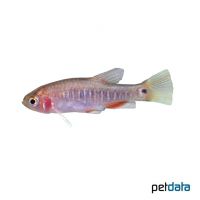Emerald Dwarf Rasbora (Danio erythromicron)
| Emerald Dwarf Rasbora Danio erythromicron | |
|---|---|
| Name | Emerald Dwarf Rasbora |
| Name Lat. | Danio erythromicron |
| Synonym | Celestichthys erythromicron |
| Family | Danios |
| Family lat. | Danionidae |
| Order | Carps |
| Order lat. | Cypriniformes |
| Origin | Myanmar, Lake Inle |
| Habitat | Lakeside |
| Diet | Omnivore |
| pH | 7.0-8.0 |
| Behavior | Peaceful |
| Keeping | Group |
| Care Level | Moderate |
| Reproduction | Egg scatterer |
| Breeding | Difficult |
| Life Span | 2-4 years |
| Protection | No |
| Metric Units | |
| Size | 2-3 cm |
| Temperature | 20-24 °C |
| Hardness | 12-20 °dH |
| Aquarium | ~ 60 l |
| US Units | |
| Size | 0.8"-1.2" |
| Temperature | 68-75 °F |
| Hardness | 214-356 ppm |
| Aquarium | ~ 15 gal |
Distribution and habitat
The cross-striped dwarf danios are found in Inle Lake and its catchment area in eastern Myanmar. There they live in the dense vegetation near the shore in the clear water between reeds and water plants.
Maintenance
The aquarium should have very dense planting, partly with Java moss. A dark, muddy substrate, some shaded light (floating plants) and medium to hard water is ideal
No ammonia, ammonium and nitrite should be detectable, the nitrate value should not exceed 100 mg/l. To ensure the water quality and oxygen content, a filter and heater adapted to the aquarium size is required, as well as lighting for the species-appropriate day-night rhythm of the animals.
Diet
In nature they feed on insects, small crustaceans, zooplankton and algae. The food supply consists of live, frozen and dry food. For a balanced diet, feed once a day with a high-quality dry food (flakes, granules, pellets) as well as cyclops, daphnia moina or artemia (live or frozen). In addition, they need regular plant food, such as algae leaves, algae wafers, scalded leafy and wild vegetables or dry food with plant ingredients (e.g. spirulina).
It is recommended to feed small portions several times a day. Only feed as much as will be eaten within a few minutes. A regular and varied diet promotes health and increases resistance.
Behaviour and compatibility
They are shy, peaceful schooling fish and can be socialized well with other small, not too lively and peaceful fish. In groups that are too small, the males behave aggressively within the species. They should be kept in a group of at least 10 animals.
Basically, only compatible fish species with similar demands on water condition and water temperature should be socialized.
Sex dimorphism
The males are more colorful and slender than the more rounded appearing females.
Reproduction and breeding
They are free spawners. The male swims around (drifts) the female, which spawns among fine-feathered plants. The larvae hatch after about 24 hours and swim freely after 3-4 days. The parents do not engage in brood care and should be separated from the fry after spawning, as they are spawn predators.
Fry must be fed several times a day with special rearing food (Artemia nauplii). Breeding is hardly possible in community tanks, as the spawn is easy prey
Important
When fed with live food and in a densely planted aquarium they show their most beautiful coloration. Soft water is not tolerated well in the long run and their colors fade.
The foliage (sea almond tree, oak, etc.) when rotting promotes the development of microorganisms, which are a valuable secondary food source
The well-being of the fish should be monitored regularly. Temperature should be checked daily, pH, hardness and nitrate levels at least every 14 days. Regular partial water changes are recommended, even when contaminant levels have not yet reached the upper limit. Sudden changes in water quality should be avoided. Newly introduced fish must be accustomed slowly to the water in the aquarium.
Further literature can be found in your pet store.
References
Text: Werner Winter; Image: petdata
Source: BMELV (1998): Tierschutzgutachten - Haltung von Zierfischen (Süßwasser); BAENSCH & RIEHL (2004): Aquarien Atlas Bd. 2, Mergus Verlag; ENGELMANN (2005): Zootierhaltung - Tiere in menschlicher Obhut: Fische, Verlag Harri Deutsch
- Gemäß § 21 Abs. 5 Tierschutzgesetz idgF
